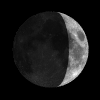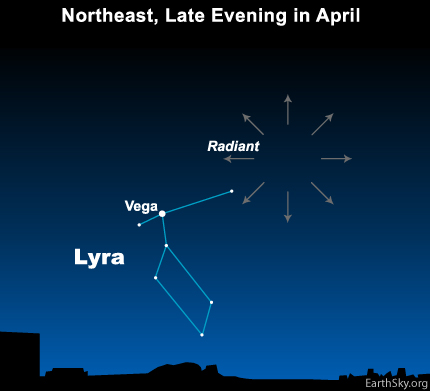Courtesy of EarthSky
A Clear Voice for Science
www.EarthSky.org [1]
 [1]
[1] [2]
[2]
The 2010 Lyrid meteor shower is now picking up steam. This shower is expected to produce the most meteors in the dark hours before dawn on Thursday, April 22 [3]. The evening before, on April 21, Mars will be near the moon [3].
The approximate direction of the radiant point for the Lyrid meteors is toward Vega, the heaven’s 5th brightest star and the brightest light in the constellation Lyra. The radiant point for the meteors sits just to the right of Vega. What does this mean? It means that if you trace the path of a Lyrid meteors backwards on the sky’s dome, you’ll see that meteor radiated – or appeared to spring – from a point near this bright star.
You do not need to identify Vega in order to watch the meteor shower. The meteors will appear in all parts of the sky, especially between midnight and dawn on April 22. Why between midnight and dawn? Vega rises above your northeast horizon around 9 to 10 p.m. and climbs upward through the night. The higher Vega climbs into the sky, the more meteors that you are likely to see. By midnight, Vega is high enough in the sky that meteors radiating from her direction streak across your sky – instead of shooting down below your horizon. Just before dawn, Vega and the radiant point shine straight overhead. That’s one reason the most meteors will be visible then.
The Lyrids are usually a modest shower. You can expect to see perhaps 15 meteors per hour. That’s in contrast to the year’s best showers – the Perseids of August and Geminids of December, both of which typically produce about 60 meteors per hour. However, with the April Lyrids, outburts of several times the usual number – perhaps up to 60 an hour or so – have been known to occur on rare occasions. Unfortunately, these meteor outburts are not predictable. You just have to recline outside in a dark location, breathe in the night air, gaze up at the starry heavens and wait and see.
The radiant point of this meteor shower marks the direction in space – as viewed from Earth – where Earth’s orbit intersects the orbit of space particles left behind by Comet Thatcher. This comet is considered the “parent” of the Lyrid meteors. When these particles enter Earth’s atmosphere, they spread out a bit before they grow hot enough (due to friction with the air) to be seen. So meteors in annual showers are typically seen over a wide area centered on the radiant, but not precisely at the radiant.
The moon is in a good place for this year’s Lyrid meteors. It will set in the wee morning hours, leaving dark skies before dawn for the 2010 Lyrid meteor shower.
Related:
EarthSky’s meteor shower guide for 2010 [4]
Written by Larry Sessions
http://tycho.usno.navy.mil/cgi-bin/phase.gif [5]
Other Links:
Astronomy Picture of the Day from NASA/JPL [6]
U.S. Naval Observator Astronomical Information cente [8]r
StarDate Online [9]
Sky and Telescope [10]
National Geographic [11]
Space Com [12]
Amazing Space [13]
The York County Astronomical Society [14]
Scope City [15]